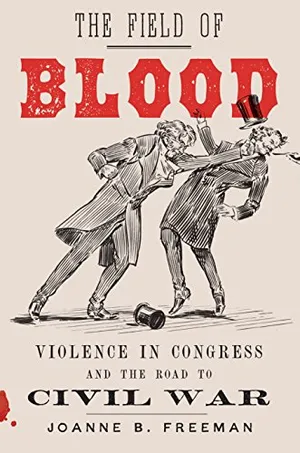Before the Civil War, Congress Was a Hotbed of Violence
A new book from historian Joanne Freeman chronicles the viciousness with which elected officials treated each other
/https://tf-cmsv2-smithsonianmag-media.s3.amazonaws.com/filer/07/a3/07a35dc9-78bc-48b8-81e0-ec1c614a432a/southern_chivalry-wr.jpg)
Scuffles seem to break out in parliaments and legislatures around the world. The last few years saw a brawl in Taiwan, a face-punch in Ukraine and a mass fight in South Africa.
The floor of the U.S. Congress is home today to plenty of verbal abuse and name-calling, but rarely sees anything physical. In her new book, Field of Blood, Joanne B. Freeman, Yale professor of history and American studies, finds that violence used to be the norm in the Capitol, almost two centuries ago, when fists flew, pistols were drawn and the threat of violence was all pervasive. She writes, “The antebellum Congress had its admirable moments, but it wasn’t an assembly of demigods. It was a human institution with very human failings.”
The Field of Blood: Violence in Congress and the Road to Civil War
In The Field of Blood, Joanne B. Freeman recovers the long-lost story of physical violence on the floor of the U.S. Congress.
Bearing witness to those failings was Benjamin Brown French, a New Hampshire lawyer and editor who worked in Washington in the lead up to the Civil War. During his four decades in the nation’s capital, he crossed paths with presidents, learned the inner-workings of politics and journaled almost daily about the violence and tension he saw there. Freeman mined French’s work to provide an insider’s perspective on an increasingly contentious Congress.
Freeman’s book Field of Blood: Violence in Congress and the Road to Civil War (Farrar, Straus and Giroux) is out on September 11. She spoke with Smithsonian about what antebellum Congress was really like.
Who is our guide to Washington in your book?
Benjamin Brown French came to Washington in 1830 and died there in 1870. And the entire time he was there, he was essentially either in Congress as a clerk or surrounded by Congressmen. So he was the ideal eyewitness for the world of the antebellum Congress. And in his diaries and in his letters to his brothers and sister, he has a gripping, you-are-there way of understanding the culture and climate.
At the beginning of my book, he's a very collegial fellow. People liked him, all parties, North and South. And by the end, he goes out to buy a gun in case he needs to shoot some Southerners. My question for the book was: How does a person begin thinking, "I love my country. I shall do anything for the Union. I like everyone. Everyone likes me," to "I better carry a gun in case some Southerners do something risky on the street to me"?
You write that he always seemed to be at the right place at the right time. What were some of the things that he witnessed?
There was an assassination attempt against President Andrew Jackson that French saw happen. John Quincy Adams has a stroke after his presidency, when he's serving in the House. He's pulled off the floor into a room off of the House, and French is there by his side holding his hand.
Most striking of all, when President Lincoln is assassinated, French is in the middle of it. By that point, he's in charge of, in essence, security in Washington. So he's running around trying to close buildings. He stands by Lincoln's side after he dies, while waiting for people to come and deal with the body. It's remarkable the degree to which [events that] we would consider the smash-bang highlight moments of this period, French doesn't necessarily play a central role in any of them. But he saw them, and even better, he wrote about them.
What was Congress like in the decades leading up to the Civil War?
The paintings from the time show senators in black frocks debating, their fingers thrust into the air in emphasis. But in truth, Congress was a violent place. That was in part because the nation was violent, too. There were riots in cities over immigration and fighting on the frontier over Native American land. The system of slavery was grounded in violence. It was not a kind era.
A lot of people have heard of the caning of Charles Sumner in the Senate chamber in 1856, but you found many more examples.
I found roughly 70 violent incidents in the 30 years before the Civil War—and very often the incidents featured a Southerner trying to intimidate a Northerner into compliance. It’s all hidden between the lines in the Congressional record; it might say “the conversation became unpleasantly personal.” That meant duel challenges, shoving, pulling guns and knives. In 1858, South Carolina representative Laurence Keitt started trouble with Pennsylvania's Galusha Grow. It turned into a mass brawl between Southerners and Northerners in the House.
How did voters feel about the violence?
That changes over time, which isn't surprising. And it wasn't the same for everyone. There were certain people who were elected to Congress because they played rough. That's why their constituents sent them there, to play rough, to defend their interests with gusto. And that included sometimes threats and even also sometimes fists or weapons.
People knew who they were electing to Congress, and they did it for a reason. The most striking example of that is, over time, increasingly confrontational Northerners get sent to Congress.

What role did the press play in the violence?
Over time, it played a more central role as things like the railroad, the telegraph, the steam powered printing press, and new ways of creating paper—there are all of these technological innovations that make the press bigger and faster and further reaching between the 1830s and the Civil War.
What starts out as a pretty small press community, in which Congressmen knew who was sitting in the House and Senate recording things and often went and corrected the record, changes to all kinds of people from all over the country reporting in Congress, relying on the telegraph to be able to send their messages home. And Congressmen don't have control of that spin. The press begins to play a more central, obvious role.
Do you think this atmosphere helped push the country toward war?
It fueled the progression. Southerners came to see Northerners as weak, because they put up with the bullying. And if you’re a Northerner in Congress, how do you say, “I’m up for a compromise”? You’re going to look like a coward. The press played up the fighting, creating an endless loop of anger. This wasn’t just about goofy guys in Washington—what goes on in Congress reflects the state of the nation.
When writing the book, did you see similarities or differences to the tension in our contemporary Congress? Could this type of physical violence occur in Congress today?
I have no idea whether it could happen in the modern Congress. Partly because who knows what's going to happen about anything at this point. To get to the point, in modern day, where you have physical violence, that would suggest such an extreme division on such a high level between people, that they can't even really see themselves as playing on the same team at all. That would be meaningful and really worrying, I would say.
A Note to our Readers
Smithsonian magazine participates in affiliate link advertising programs. If you purchase an item through these links, we receive a commission.
